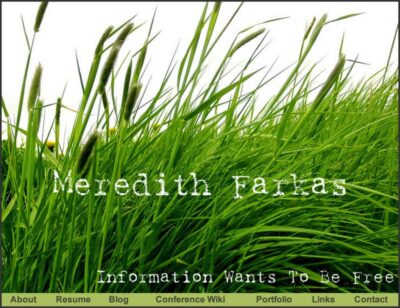Participants: Amanda Etches-Johnson, Aaron Schmidt, and Michael Stephens
Why are we spending so much money on commercial software when we could just put an IM name online for our patrons?
There are 65 libraries currently providing IM on the Library Success Wiki.
Michael Surveyed a bunch of librarians on IM
50.5% are allowed to use IM for professional and personal use.
25.6% says that they are not allowed.
62% of librarians do not provide outreach via IM.
25.3% of academic librarians use IM.
Survey says!: not enough libraries are using IM to reach their users. Our patrons are interacting via IM, so we should too.
89% of librarians agree that IM builds community among colleagues. Only 53% feel they’re a part of that community.
One academic librarian has said that IM is building bridges across the staff/faculty divide.
Barriers
- Some people think IM is intrusive
- Some people think IM is too time-consuming
- Some IT departments disallow or block IM due to “security issues.”
- It creates a digital divide versus “last gen” librarians and “next gen” librarians
- Policies that IM is a waste of time
Michael had the great idea for a directory of IM screen names of all IM-ing librarians. All you gotta do is ask! See this page on the Library Sucess wiki
Aaron tells us that MySpace is now going to soon have an external IM client. Will this be bigger than AIM?
Most communities in libraries are for older folks.
At Thomas Ford Memorial Library: 75% of questions are from children and teens.
You will get the same sort of questions on IM that you will get on a virtual reference desk.
People who IM often use slang and abbreviations. Young people have their own IM shorthand. It’s important that librarians are aware of the slang.
Community building aspects of IM: Users were adding the library screen name to their buddy list. If we live on their buddy list, we are basically in their home. They know when we’re online as soon as we go online. We want people to add us to their buddy list so that we are the first person they go to online.
Commercial virtual reference is expensive and it makes patrons jump through hoops (i.e. use a client they are not familiar with).
Amanda Etches-Johnson is up now. She works in an academic library and offers IM reference through AIM, MSN and Yahoo! Messenger. They had never before used commercial virtual reference.
What they’ve gotten out of IM: Helping users makes them feel good. Offering a user-centered service makes us feel good. IM is good and we like being cool.
Amanda asks: are we building community in this academic environment? Evidence-based practice is a big part of what they do at McMaster. They have found from students that they humanize the reference desk. IM makes reference librarians approachable. We’re in our user’s space rather than making them go to our space.
Some academic librarians are bringing other groups (IT, etc.) into the IM conversation to help the patrons.
They keep logs with the personal information stripped out, so Amanda showed us some successful conversations.
They have a lot of repeat users. Repeat user = success
They have indicators on their Web site that tells people when they’re online.
So IM reference services: encourages students to keep coming back, puts us in our user’s space, fosters collaboration, and humanizes the reference desk.
An audience member asked, does it ever get too personal? Are people inappropriate? Aaron says that people get like that at the physical desk too (they want someone to talk to) and so you deal with it the same way.
How do you handle a bunch of IM’s at once? Some people multitask, others tell patrons that they’re with another patron and that they need to wait a bit. At SJCPL, they can transfer IMs to another librarian.
Aaron says that they are answering questions at the reference desk and that it’s first come first serve, regardless of what media they are using to access a librarian. This is a BIG question for libraries who are thinking about IM.
[tags]cil2006[/tags]




Pingback: 用即时通讯建立社区 « 图林中文译站
hello,dear Meredith.I am a chinese librarian,and I want to introduce this post to the librarian of china.
we also give many attention to the CIL2006. If permitted,I’ll continue to translate your posts into chinese.
I like your blog,and many chinese librarian bloggers subscribe your blog too.
Thanks for your record of the meeting. maybe I can say,librarians all of the world have one thing to do,learn from each other and improve our service.
thanks again.
Meredith!
thanks for taking the time to post this. I’d been talking about IM for years and years and years! In my current position I’m actually having great success brining together the geographically dispersed librarians who staff our VR service through IM and some of them have found out they can get my help while they are still with their customer. And the fact that they get comfy by chatting with their peers is just an added bonus.
Years ago, the closest success I had was at a large public library where two librarians used telephone and netmeeting software to collaborate on one document together. it was still a win.
As I keep telling the VR staff, they have spent years of their life communicating through speech, hoing their speech reference skills… they can’t expect to become expert chatters or VR librarians after just a few hours! change takes time. And a reason to keep practicing, so I signed myself up on the success wiki. Not expecting great and wonderful things, but if even one thing comes of it, it was a minute of my life well spent. time to pass this meme onwards!
marcus
Pingback: 一思不狗 » Blog Archive » 周末博餐反刍
IM 在圖書館的應用
Meredith Farkas è¨éäºç± Amanda Etches-JohnsonãAaron Schmidtãå Michael Stephens å¨ CIL 2006 æ主è¬çå ´æ¬¡: Building Community With IMãå¾æä¸æè¯ç« å¾å¿«å°�…
Pingback: 蜗牛搬家 :: IM及其在图书馆的应用 :: April :: 2006
Pingback: 蜗牛搬家 :: IM及其在图书馆的应用 :: April :: 2006
Pingback: 蜗牛搬家 :: IM及其在图书馆的应用 :: April :: 2006
Pingback: 蜗牛搬家 :: IM及其在图书馆的应用 :: April :: 2006
Pingback: 蜗牛搬家 :: IM及其在图书馆的应用 :: April :: 2006
Pingback: 蜗牛搬家 :: IM及其在图书馆的应用 :: April :: 2006
Meredith
It seems to me that the rhetoric of “IM builds community” misrepresents what actually happens when we offer IM services.
Libraries that offer IM are joining, potentially, the community of each indivdiual user. This is important and great, but it is not the same as building community. I’d love to be mistaken, but I don’t see individual persons who IM the library engaging with one another because they IM’d the library.
I’m curious – what argument do they put forward for IM-building-community?
Caleb, to be honest, I completely agree with your statement, and I didn’t really see the speakers in this panel talking about how IM builds a community. I think the talk was more about how IM puts the library into the user’s community. It’s more about making the library approachable and human by integrating ourselves into our user’s everyday life.
It’s kind of like the idea that having a library blog will build community. Well… not unless it’s like the Ann Arbor District Library blogs where people are commenting and real conversations are going on. But in my research, I’ve found very few libraries that have blogs that I’d consider communities. It’s more like, blogs are putting us into a realm where our patrons are.